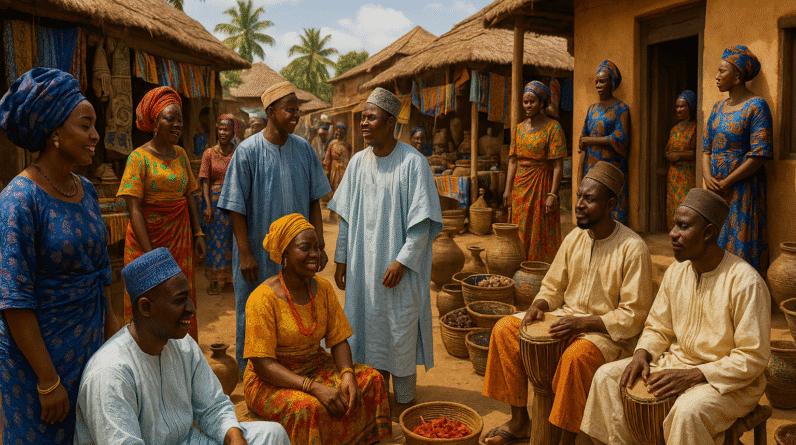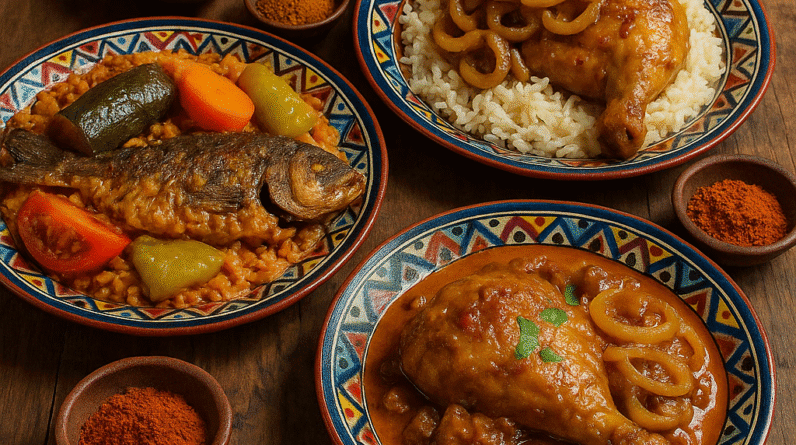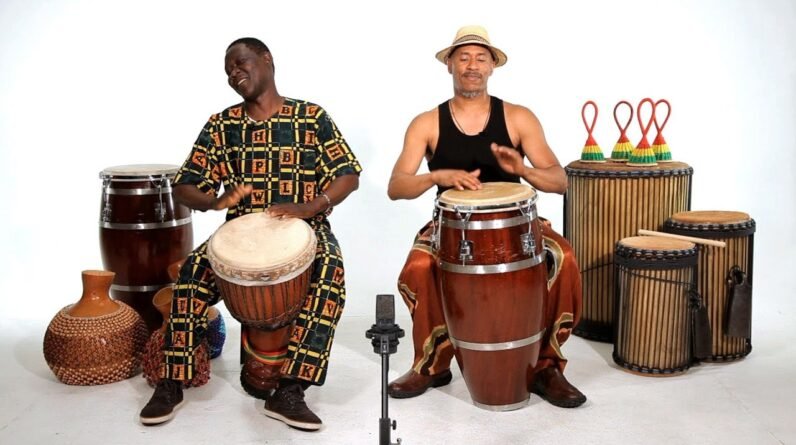
What Is The Difference Between A Djembe And A Conga Drum?
What Is The Difference Between A Djembe And A Conga Drum? Are you curious about the key disparities distinguishing a Djembe from a Conga drum? Look no further! In this article, we will uncover the essential dissimilarities in these two unique percussion instruments. Whether you’re an avid musician, a casual listener, or simply someone interested in learning about different types of drums, this insightful piece will provide you with a comprehensive understanding of the distinctions between a djembe and a conga drum. So grab a seat, join us on this melodic journey, and let’s explore the captivating world of rhythm and beats!
Design
Size
When it comes to size, both the djembe and conga drums have their own unique dimensions. The djembe drum typically stands around 60 to 70 centimeters tall, with a diameter ranging between 30 to 40 centimeters. On the other hand, conga drums have a slightly larger size, usually measuring around 75 to 90 centimeters tall, with a diameter of approximately 28 to 30 centimeters.
Shape
While both the djembe and conga drums are percussion instruments, they differ in terms of their overall shape. The djembe drum has a traditional goblet shape, resembling a large bowl. This unique design allows for a wider range of tones and sounds to be produced. In contrast, the conga drum features a taller and more narrow shape. This shape helps to create a distinct and deep bass sound.
Materials
The materials used to construct these drums are another aspect that sets them apart. Typically, a djembe drum is crafted from a single piece of wood, most commonly known as lenke, which is native to West Africa. The drum’s head, or “skin,” is traditionally made from goat or cowhide. Conga drums, on the other hand, are often made from staved wood, with each stave carefully shaped and put together to form the drum’s body. The drumhead of a conga can be made of various materials such as rawhide or synthetic materials like fiberglass.
Origins and Cultural Significance
Djembe
The djembe drum originates from the Mandé people of West Africa, specifically from the countries of Guinea, Mali, and Burkina Faso. This percussion instrument has a significant cultural significance within these regions and is used in various ceremonies, traditional events, and celebrations. Historically, djembes were played to communicate important messages, transmit news, and bring communities together.
Conga Drum
Conga drums, on the other hand, have their roots in Afro-Cuban music and culture. They were brought to the Americas by African slaves and became an integral part of Afro-Cuban and Latin American music. Congas gained popularity in the mid-20th century when they were incorporated into various genres such as jazz, salsa, and rumba. Today, they continue to be widely used in numerous musical styles across the globe.
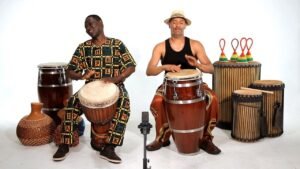
Playing Technique
Hand Position
When it comes to playing the djembe, the hand position is crucial for producing different sounds and tones. Traditionally, the player’s hands are positioned on the drumhead, with the fingers slightly curved and the palms slightly cupped. This technique allows for a wide range of sounds, from deep bass tones to crisp slaps.
Similarly, conga drum playing technique also involves specific hand positioning. The player’s hands are typically placed on the drumhead, with the fingers extended and the palms flat. This allows for clear and distinct tones to be produced, with variations created by hitting different parts of the drum.
Striking Techniques
Both the djembe and conga drum utilize a variety of striking techniques to produce different sounds. In djembe playing, players commonly use three main striking techniques: bass, tone, and slap. The bass is created by striking the center of the drumhead with the palm and fingers to produce a deep, resonating sound. The tone is achieved by hitting the drumhead with the fingers, generating a mid-range melodic tone. Lastly, the slap involves striking the drumhead with the fingers and palm in a slapping motion, creating a sharp and crisp sound.
Similarly, conga drums employ different striking techniques to produce distinct tones. The open tone is created by hitting the center of the drumhead with the fingers, generating a clear and resonant sound. The slap technique, similar to the djembe, involves striking the drumhead with the fingers and palm in a slapping motion to produce a sharp and bright sound. Additionally, conga players often use the closed slap technique, where the fingertips and palm make contact with the drumhead, resulting in a muted and dry sound.
Tonal Range
Both the djembe and conga drum offer a wide tonal range, allowing for expressive and versatile playing. The djembe, with its goblet shape, offers a greater range of tones. Players can produce deep bass notes, clear tones, and sharp slaps, giving the instrument a rich and dynamic sound. Conga drums, although slightly more limited in their tonal range, excel at producing deep, resonant bass tones and clean, crisp open tones. The unique shape of the conga drum contributes to its distinct sound characteristics.
Sound Characteristics
Djembe
The djembe drum possesses unique sound characteristics that contribute to its popularity and appeal. It produces a wide range of tones, from deep, resonant bass notes to bright and sharp slaps. The bass tones are rich and booming, providing a solid foundation for rhythm and melody. The tones have a melodic quality, with varying pitches depending on the striking technique used. Slaps are crisp and energetic, adding a vibrant and lively element to the overall sound.
Conga Drum
Conga drums are known for their distinct sound characteristics that have made them a favorite in numerous musical genres. The deep bass tones produced by congas are powerful and resonate, providing a solid rhythmic foundation. The open tones are clear and vibrant, offering a melodic quality to the overall sound. Slaps on conga drums are sharp and cutting, adding a percussive edge to the music. Combined, these sound characteristics make the conga drum a versatile instrument capable of creating a wide range of rhythmic patterns and melodic expressions.

Musical Styles and Context
Djembe
The djembe drum is deeply embedded in the cultural music of West Africa. It is a fundamental instrument in traditional West African music genres such as Malinke, Wolof, and Mandinka. These genres often feature intricate rhythmic patterns and energetic performances that showcase the expressive capabilities of the djembe. Additionally, the djembe has also found its way into contemporary world music, fusion genres, and even pop music, adding a vibrant and authentic African sound.
Conga Drum
Conga drums have found their place in a variety of musical styles and contexts. They are widely utilized in Afro-Cuban genres such as salsa, mambo, and rumba, where their rhythmic patterns drive the music and create an infectious energy. Congas are also essential in Latin jazz, providing rhythmic complexity and adding a dynamic element to the music. Moreover, the conga drum has made its mark in popular music, frequently heard in various genres ranging from rock to fusion and beyond.
Popularity and Global Reach
Both the djembe and conga drums have gained immense popularity and have achieved a global reach. The djembe’s infectious rhythms, unique design, and cultural significance have captured the interest of musicians and enthusiasts worldwide. It has become a popular instrument in drum circles, workshops, and music therapy programs due to its accessible nature and the joy it brings through communal playing. Similarly, conga drums have found a global following, particularly in Latin America, North America, and Europe. Their mesmerizing rhythmic patterns and versatility have made them a staple in many musical genres and performances worldwide.
Cost and Availability
The cost and availability of both djembe and conga drums can vary depending on various factors such as the materials used, craftsmanship, and brand reputation. Djembe drums, being primarily handcrafted from specific types of wood, can range in price from relatively affordable to more expensive for higher quality or collector pieces. Additionally, the availability of djembe drums can also depend on the region and the access to skilled artisans who create them.
Similarly, conga drums are available in a wide range of prices, depending on factors such as construction quality, materials used, and brand reputation. Entry-level congas can be relatively affordable and suitable for beginners, while professional-grade congas made from high-quality materials can be more expensive. Availability of conga drums may also vary based on geographical location and the local demand for percussion instruments.
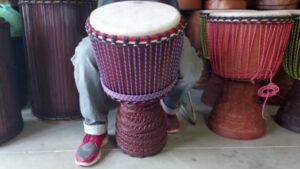
Physical Appearance
Djembe
The physical appearance of a djembe drum is distinctive and easily recognizable. Its goblet-shaped body is typically carved from a single piece of wood, showcasing the craftsmanship and skill of the maker. The drumhead, or “skin,” is usually made of goat or cowhide, stretched tightly across the top of the drum shell and secured with a system of ropes or tuners. Djembes are often adorned with beautiful hand-carved designs, representing cultural symbols and patterns specific to the region and the artisans who craft them.
Conga Drum
Conga drums have a sleek and elegant appearance. Their tall and narrow shape, crafted from staved wood, is smooth and polished, giving them a refined aesthetic. The drumheads of congas can be made from various materials, including rawhide or synthetic materials. The tension of the drumhead is adjusted using metal tuning lugs, allowing players to fine-tune the sound. Conga drums come in various colors and finishes, offering a visually appealing instrument that catches the eye onstage or in any musical setting.
Maintenance and Care
To ensure the longevity and optimal performance of both djembe and conga drums, proper maintenance and care are necessary. Djembe drums should be kept in a dry environment to prevent warping or cracking of the wooden shell. The drumhead can be periodically conditioned with natural oils to preserve its lifespan and maintain its sound quality. Regular tuning of the drumhead ropes or tuning system is also important to keep the drum in tune.
Conga drums should also be stored in a cool and dry place, as changes in temperature and humidity can affect the drum’s integrity. The drumheads should be periodically inspected for any signs of wear and tear and replaced if needed. Regular cleaning, using appropriate materials and methods depending on the drumhead material, is crucial to remove sweat, dirt, or oils that can affect the sound quality. Additionally, tuning the conga drum regularly ensures optimal performance and sound projection.
Exploring the Differences Between a Djembe and a Conga Drum? FAQs
What Is The Difference Between A Djembe And A Conga Drum?
The djembe and conga drum are both celebrated percussion instruments, but their shapes are distinctly different. The djembe has a goblet shape with a wide, flared top and a narrow base, designed for optimal resonance and ease of play. This shape allows the djembe to produce a wide range of tones from sharp slaps to deep bass notes. On the other hand, the conga drum is cylindrical and typically taller, with a slightly tapered body that flares out towards the top. This design gives the conga its characteristic deep and resonant sound, suitable for the complex rhythms of Afro-Cuban music.
How do the sizes of djembes and conga drums compare?
Djembes and conga drums vary significantly in size. Djembes generally range from 12 to 15 inches in diameter and about 24 inches in height, making them relatively portable and easy to play while seated or standing. In contrast, conga drums come in several sizes, each with a specific name and role in a drum ensemble. The smallest is the quinto, followed by the conga, and the largest is the tumba. Congas can be up to 30 inches tall, with diameters ranging from 9 to 13 inches. This variation in size influences their role in musical compositions, with each drum providing different tonal qualities.
What materials are typically used to make djembes versus conga drums?
The materials used to craft djembes and conga drums also highlight their cultural and functional differences. Traditional djembes are carved from a single piece of hardwood, such as lenke or mahogany, and the drumhead is made from goatskin, providing a crisp, clear sound. Modern djembes might use synthetic materials for the shell and drumhead for durability and ease of maintenance. Conga drums, however, are often made from staved wood, such as ash or oak, or from fiberglass, offering robustness and a distinct tonal quality. The drumheads of congas are usually made from cowhide or synthetic materials, designed to withstand the rigorous playing techniques of Afro-Cuban music.
How do the sounds produced by a djembe differ from those produced by a conga drum?
The sounds of a djembe and a conga drum are quite distinct, each suited to different musical styles and contexts. A djembe is known for its versatile range of tones, capable of producing deep bass notes, sharp slaps, and rich tones, making it ideal for the dynamic rhythms of West African music. The drum’s wide head allows for varied hand techniques to extract different sounds. Conga drums, in contrast, have a more focused and melodic tone. The quinto, conga, and tumba each contribute unique pitches to the ensemble, creating intricate, interlocking rhythms essential to Afro-Cuban music. Congas are known for their rich, warm sound that blends seamlessly with other percussion instruments.
What are the traditional origins of the djembe and the conga drum?
The djembe and conga drum each have rich histories rooted in their respective cultures. The djembe originates from West Africa, specifically among the Mandinka people of Mali. It is traditionally used in ceremonies, celebrations, and communal gatherings, where it plays a crucial role in the musical and cultural expressions of the community. The conga drum, on the other hand, has its roots in Afro-Cuban culture, evolving from the African drums brought to Cuba by enslaved Africans. Congas are central to genres like rumba, salsa, and mambo, where they drive the complex rhythms and improvisational spirit of these musical styles.
How is the playing technique for a djembe different from that of a conga drum?
Playing techniques for the djembe and conga drum vary significantly, reflecting their distinct musical roles. Djembes are typically played with the hands, using a combination of bass, tone, and slap strokes to produce a wide array of sounds. The technique involves intricate hand movements and precise strikes, allowing the player to create complex, polyrhythmic patterns. Conga drums, while also played with the hands, involve a different set of techniques, including open tones, slaps, and muted strokes. Players often use the fingers and palms in various combinations to produce the drum’s characteristic melodic and rhythmic sounds. Additionally, conga players might use multiple drums, each tuned to a different pitch, to add depth and complexity to the music.
In what types of music are djembes and conga drums commonly used?
Djembes and conga drums are integral to different musical traditions. The djembe is primarily associated with West African music, including traditional drumming ensembles and contemporary African genres. It is also popular in world music and fusion styles, where its dynamic range and expressive potential are highly valued. Conga drums are central to Afro-Cuban music, including genres like salsa, rumba, and son. They are also widely used in jazz, Latin jazz, and various forms of popular music, where their rhythmic complexity and melodic potential add a distinctive flavor to the ensemble.
What are the typical tuning methods for djembes compared to conga drums?
Tuning methods for djembes and conga drums reflect their construction and musical roles. Djembes are traditionally tuned by tightening or loosening the ropes that hold the drumhead in place. Modern djembes might use mechanical tuning systems with metal rings and lugs to adjust the tension more precisely. Proper tuning ensures the drum produces its characteristic range of tones. Conga drums, on the other hand, typically use tuning lugs and bolts around the drumhead. By tightening or loosening these bolts, players can adjust the pitch of each drum. This allows for precise tuning of the quinto, conga, and tumba, essential for their role in ensemble playing.
How do the cultural significances of djembes and conga drums differ?
The cultural significance of djembes and conga drums is deeply rooted in their respective histories and communities. The djembe is more than a musical instrument; it is a symbol of community, communication, and cultural identity in West African societies. It is often used in ceremonies, storytelling, and rituals, serving as a medium for social and spiritual expression. Conga drums, similarly, are central to Afro-Cuban cultural and musical traditions. They embody the fusion of African and Cuban influences, playing a key role in social dances, religious ceremonies, and popular music. Both instruments, while different, serve as cultural ambassadors, preserving and promoting their rich heritages.
What are the typical maintenance practices for djembes versus conga drums?
Maintaining djembes and conga drums requires different approaches due to their construction and materials. For djembes, regular inspection of the drumhead and ropes is essential. The drumhead should be kept clean and occasionally treated with oils to prevent drying and cracking. Ropes may need to be tightened or replaced to maintain proper tension. Conga drums, with their tuning lugs and bolts, require periodic tightening to ensure the drumheads remain in tune. The drumheads, often made of animal hide, should be kept clean and occasionally conditioned. Both instruments should be stored in a dry, cool place to prevent damage from humidity and temperature changes, ensuring their longevity and optimal sound quality.
Conclusion
In conclusion, the djembe and conga drums are both fascinating percussion instruments with their own unique characteristics and cultural significance. Their differences in size, shape, materials, and sound provide musicians with a variety of options to choose from based on their musical preferences and stylistic needs. Whether it’s the djembe drum’s melodic tones and rich cultural heritage or the conga drum’s rhythmic complexity and versatility, both instruments continue to captivate musicians and audiences worldwide. So, whether you choose the djembe or the conga drum, get ready to embark on a rhythmic journey filled with expression, creativity, and joy.


